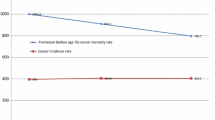Abstract
We perform an econometric analysis of the effect of new drug launches on longevity, using data from the IMS Health Drug Launches database and the WHO Mortality Database. Under conservative assumptions, our estimates imply that the average annual increase in life expectancy of the entire population resulting from new drug launches is about one week, and that the incremental cost effectiveness ratio (new drug expenditure per person per year divided by the increase in life-years per person per year attributable to new drug launches) is about $6750—far lower than most estimates of the value of a statistical life-year.
Similar content being viewed by others
References
Agency for Healthcare Research and Quality (2002). “MEPS H38Codebook: 1999 Full Year Consolidated Data File Codebook.”November 27, http://www.meps.ahrq.gov/Pubdoc/HC038/H38CB.pdf
Arias, E. (2002). “United States Life Tables, 2000.”National Vital Statistics Reports 51(3). (Hyattsville, MD: National Center for Health Statistics).
Berndt, Ernst, Margaret K. Kyle, and Davina Ling (2003). “The Long Shadow of Patent Expiration: Do Rx to OTC Switches Provide an Afterlife?.”In Robert C. Feenstra and Matthew D. Shapiro (eds.), Scanner Data and Price Indexes, Chicago: University of Chicago Press.
Bresnahan, T. and R. Gordon (1997). The Economics of New Goods. Chicago: University of Chicago Press.
Cutler, D. and M. McClellan (2001). “Is Technological Change in Medicine Worth It?”Health Affairs 20(5), 11–29.
Danzon, P., Y. R. Wang, and L. Wang (2003). “The Impact of Price Regulation on the Launch Delay of New Drugs—A Study of Twenty-Five Major Markets in the 1990s.” http://hc.wharton.upenn.edu/danzon/PDF Files/LaunchDelayPaper.pdf.
Folland, S., A. Goodman, and M. Stano (2001). The Economics of Health and Health Care, third edition. Upper Saddle River, NJ: Prentice Hall.
Getzen, T (1997). Health Economics: Fundamentals and Flow of Funds. New York, NY: John Wiley and Sons.
Global Forum for Health Research (2002). The 10/90 Report on Health Research 2001–2002. Geneva: Global Forum for Health Research. ISBN 2-940286-07-8. http://www.globalforumhealth.org/pages/index.asp
Grier, Holcombe et al. (2003). “Addition of Ifosfamide and Etoposide to Standard Chemotherapy for Ewing’’s Sarcoma and Primitive Neuroectodermal Tumor of Bone.”New England Journal of Medicine 348(8), 694–701.
Henderson, J. (1999). Health Economics and Policy. Cincinnati, OH: South-Western Publishing Co.
IMS Health, http://www.ims-global.com/.
Kyle, M. K. (2003). “Product Entry in Global Pharmaceutical Markets: A Cross-National Study.”Unpublished paper, Carnegie-Mellon University.
Lichtenberg, F. (1996). “Do (More and Better) Drugs Keep People Out of Hospitals?” American Economic Review 86, 384–388.
Lichtenberg, F. (2001). “Are the Benefits of Newer Drugs Worth Their Cost? Evidence from the 1996 MEPS.”Health Affairs 20(5), 241–251.
Liu, Jin-Tan, James K. Hammitt, and Jin-Long Liu (1997). “Estimated Hedonic Wage Function and the Value of Life in a Developing Country.”Economics Letters 57, 353–358.
Murphy, K. M. and R. H. Topel (2003). “The Economic Value of Medical Research.”In Kevin M. Murphy and Robert H. Topel (eds.), Measuring the Gains from Medical Research: An Economic Approach. Chicago: University of Chicago Press.
Nordhaus, W. (2003). “The Health of Nations: The Contribution of Improved Health to Living Standards.”In Kevin M. Murphy and Robert H. Topel (eds.), Measuring the Gains from Medical Research: An Economic Approach. Chicago: University of Chicago Press.
OECD Health Database. http://www.credes.fr/english/ecosante/oecd.htm.
Romer, Paul (1990). “Endogenous Technical Change.”Journal of Political Economy 98, S71-S102.
Santerre, R. and S. Neun (2000). Health Economics: Theories, Insights, and Industry Studies, revised edition. Orlando, FL: Dryden Press.
Simon, N. B., M. L. Cropper, A. Alberini, and S. Arora (1999). “Valuing Mortality Reductions in India: A Study of Compensating-Wage Differentials.”World Bank Working Paper Series #2078, March.
Stenestrand, U. et al. (2001). “Early Statin Treatment Following Acute Myocardial Infarction and 1-year Survival,”Journal of the American Medical Association 285(4), 430–436.
United Nations, World Population Prospects Population Database, http://esa.un.org/unpp/index.asp?panel = 2.
U.S. Pharmacist (2002). “Cancer News,”Vol. 27(11), posted November 15, http://www.uspharmacist.com/index. asp?show=article&page = 8_999.htm
World Health Organization, WHO Mortality Database, http://www3.who.int/whosis/whsa/ftp/download.htm.
Author information
Authors and Affiliations
Corresponding author
Rights and permissions
About this article
Cite this article
Lichtenberg, F.R. The Impact of New Drug Launches on Longevity: Evidence from Longitudinal, Disease-Level Data from 52 Countries, 1982–2001. Int J Health Care Finance Econ 5, 47–73 (2005). https://doi.org/10.1007/s10754-005-6601-7
Issue Date:
DOI: https://doi.org/10.1007/s10754-005-6601-7




